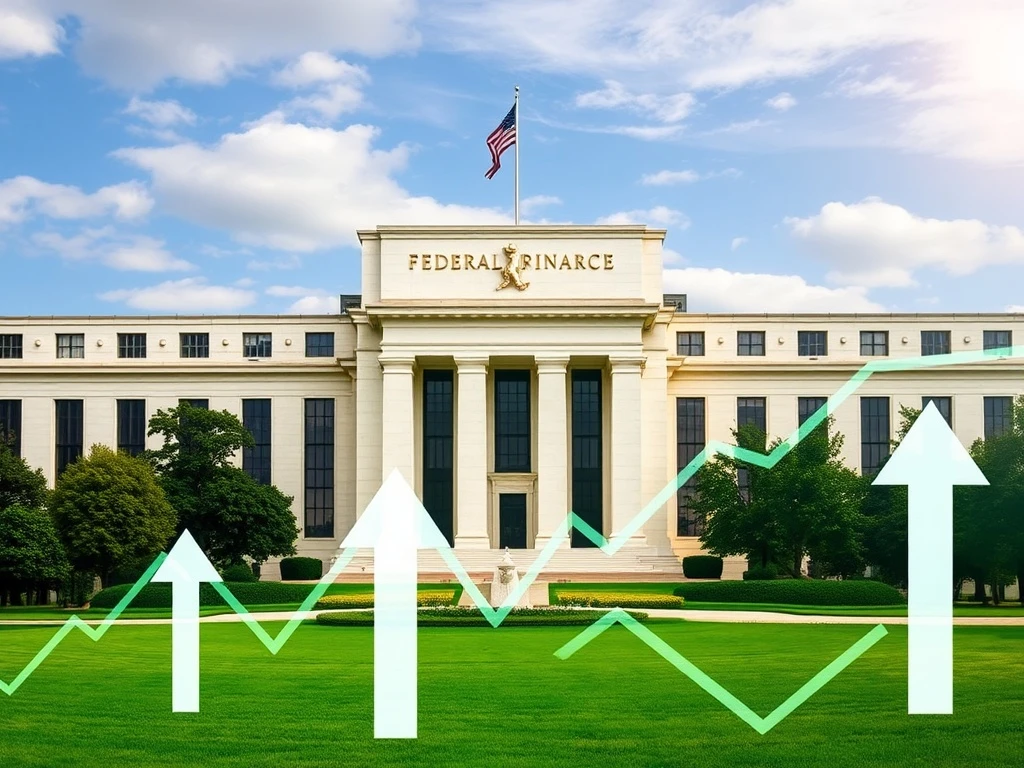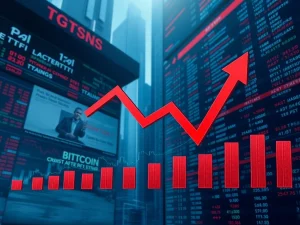Crucial Federal Reserve Rate Cut: Unveiling Crypto Market Impact Today

Today, the financial world holds its breath. The Federal Reserve stands poised to announce a significant shift in its monetary policy. This eagerly anticipated Federal Reserve rate cut directly impacts global financial markets. Furthermore, it creates substantial ripples within the dynamic cryptocurrency space. Market participants are keenly observing every signal. They expect at least a 25 basis point (BPS) interest rate cut from the Federal Reserve. This decision could reshape investor strategies. It also dictates the short-term and long-term trajectories for various risk assets, including digital currencies.
Federal Reserve Rate Cut Anticipation Builds
The United States central bank, the Federal Reserve, is widely expected to initiate interest rate reductions this Wednesday. Analysts predict a 25 basis point (bps) cut. This move aims to stimulate economic activity. Historically, such cuts boost risk assets in the long term. Crypto prices, for instance, show a strong correlation with global liquidity cycles. Nic Puckrin, founder of Coin Bureau and a prominent market analyst, highlights this connection. He notes that increased liquidity often flows into more speculative investments. Therefore, lower interest rates typically raise asset prices over an extended period. However, Puckrin also cautions against immediate euphoria. He warns of a potential short-term price correction. This is a crucial point for investors to consider.
Many traders and financial institutions have already factored in these expectations. Investment bank Goldman Sachs and banking giant Citigroup, for example, both anticipate multiple rate cuts in 2025. Oxford Economics, a leading advisory firm, forecasts a maximum of two interest rate cuts for the same period. Ryan Sweet, chief US economist at Oxford Economics, describes three cuts as “overly optimistic.” This perspective remains, even with the Federal Reserve potentially slashing rates earlier than anticipated. These differing expert opinions underscore the uncertainty in predicting future policy. Investors must therefore remain agile.
Understanding the Crypto Market Impact
The immediate crypto market impact of a rate cut is complex. While lower interest rates generally make holding cash less attractive, prompting investors to seek higher returns in riskier assets, the market often ‘prices in’ expected events. Puckrin explains, “The main risk is that the move is already priced in.” He adds, “hope is high and there’s a big chance of a ‘sell the news’ pullback.” This phenomenon occurs when an anticipated positive event materializes, but asset prices fall because the expectation had already driven prices up. When this happens, speculative corners of the market, particularly memecoins, are most vulnerable to sharp corrections. These assets often lack strong fundamental backing. Therefore, they rely heavily on market sentiment and liquidity. Investors should approach these volatile assets with caution.
A 25 BPS cut might indeed create a brief rally in risk-on assets. Javier Rodriguez-Alarcon, chief investment officer at digital asset investment company XBTO, confirms this. He suggests such a cut would provide a short-term boost. However, a more aggressive 50 BPS surprise cut could have a different effect. Rodriguez-Alarcon notes, “A 50 bps surprise, by contrast, would heighten concerns over the health of the economy and underlying growth, weighing on markets in the short term.” This is because a larger-than-expected cut might signal deeper economic troubles. Such concerns could overshadow the immediate benefits of lower borrowing costs. Ultimately, however, these cuts will likely boost asset prices in the long term. Investors typically exit cash positions to pursue more lucrative investments when interest rates are low.

Macroeconomic Fundamentals Driving Interest Rate Decisions
The Federal Reserve’s decision to implement an interest rate cut stems from evolving macroeconomic conditions. The crypto community and investors across various markets have anticipated these cuts. This anticipation follows significant downward revisions of over 900,000 jobs for 2025. These revisions signal a clear weakening in the US job market. Such deterioration in macroeconomic fundamentals provides the Federal Reserve with compelling reasons to ease monetary policy. A softer labor market typically reduces inflationary pressures. It also creates room for the central bank to lower borrowing costs without risking an overheating economy. This delicate balance is central to the Fed’s mandate.
Furthermore, the unemployment rate has spiked since 2024. This trend gives the Federal Reserve additional impetus to slash interest rates. A rising unemployment rate indicates economic contraction. It often prompts central banks to intervene with stimulative measures. Lower interest rates make it cheaper for businesses to borrow and invest. This, in turn, can spur job creation and economic growth. The Fed’s dual mandate includes achieving maximum employment and stable prices. Therefore, a weakening job market directly influences their policy decisions. Monitoring these economic indicators is vital for understanding future Fed actions. Investors must grasp these underlying drivers. They shape the broader financial landscape.

Expert Outlooks on Future Interest Rate Decisions
The consensus among financial institutions points to multiple rate cuts in the coming year. Both Goldman Sachs and Citigroup, major investment banks, foresee three cuts in 2025. This indicates a general expectation of continued monetary easing. However, not all experts share this optimistic view. Oxford Economics, through its chief US economist Ryan Sweet, projects a maximum of two rate cuts for 2025. Sweet describes the three-cut forecast as “overly optimistic.” This divergence highlights the ongoing debate among economists. They weigh the strength of the economy against inflationary risks. The Federal Reserve’s forward guidance will be critical. It will shape market expectations and investor behavior. Investors should therefore pay close attention to official statements.
These varying predictions underscore the complexity of economic forecasting. Each institution employs different models and assumptions. Factors like global supply chains, geopolitical events, and domestic consumer spending all play a role. The Fed’s decisions are not made in a vacuum. They respond to a dynamic economic environment. Consequently, market participants must consider a range of possible scenarios. This helps in building resilient investment portfolios. The macroeconomic fundamentals will continue to guide these expert analyses. Therefore, staying informed about these forecasts is crucial for making sound investment decisions.
The Crucial Difference: 25 BPS vs. 50 BPS
The magnitude of the interest rate cut significantly influences market reaction. According to the Chicago Mercantile Exchange (CME) Group, only 6.2% of traders expect a 50 BPS reduction on Wednesday. This indicates that a 25 BPS cut is largely priced in. A smaller, 25 BPS cut would likely spark a “brief rally” in risk-on assets, as stated by Javier Rodriguez-Alarcon. This immediate positive reaction would stem from reduced borrowing costs and increased liquidity. Investors would likely allocate capital to growth-oriented sectors. This includes the cryptocurrency market, which benefits from such inflows. Therefore, a modest cut offers a predictable, albeit short-lived, market bounce.
Conversely, a surprise 50 BPS cut carries more complex implications. Rodriguez-Alarcon warns that such a move “would heighten concerns over the health of the economy and underlying growth.” This could weigh on markets in the short term. A larger cut might signal that the Fed perceives deeper economic weaknesses. This could trigger investor apprehension. Despite initial market jitters, these cuts ultimately boost asset prices in the long term. Investors tend to move away from cash. They seek better returns in investments when interest rates are low. This fundamental shift supports a long-term bullish outlook for risk assets, including digital currencies. Understanding these nuances helps investors prepare for various outcomes.

Navigating Crypto Volatility Amidst Policy Shifts
Crypto markets often exhibit heightened volatility during periods of significant monetary policy shifts. The anticipated Federal Reserve rate cut is no exception. While a rate cut generally creates a more favorable environment for risk assets, short-term price movements can be unpredictable. Investors should prepare for potential ‘sell the news’ events. This means having a clear strategy for managing risk. Diversification remains a key principle. Holding a mix of different cryptocurrencies and traditional assets can help mitigate exposure to sudden market swings. Furthermore, understanding the specific use cases and fundamental strengths of individual crypto projects becomes even more critical. Speculative assets, like many memecoins, face increased scrutiny during such periods.
Long-term holders, however, may view any short-term dips as buying opportunities. The overall trend of lower interest rates supports a narrative of increasing liquidity flowing into alternative investments. This includes the digital asset space. Therefore, while navigating the immediate volatility, investors should maintain a long-term perspective. They should focus on the broader economic landscape. Educational resources, such as insights from market analysts, can provide valuable context. Staying informed about both macroeconomic fundamentals and crypto-specific developments is paramount. This balanced approach helps investors make informed decisions. It also allows them to capitalize on market opportunities.
The Broader Economic Landscape and Risk Assets
The Federal Reserve’s actions extend beyond merely influencing interest rates. They shape the entire economic landscape. When the Fed cuts rates, it aims to make borrowing cheaper. This encourages consumer spending and business investment. Consequently, it boosts overall economic activity. This environment is generally favorable for risk assets. Assets like stocks, commodities, and cryptocurrencies tend to perform well. Investors often move capital out of lower-yielding savings accounts and bonds. They seek higher returns in growth-oriented investments. This reallocation of capital fuels asset price appreciation. It creates a ‘risk-on’ sentiment across markets.
Conversely, a hawkish Fed stance, characterized by rate hikes, tends to dampen this enthusiasm. Higher interest rates make borrowing more expensive. This slows down economic growth. It can also make safer assets, like government bonds, more attractive. This draws capital away from riskier ventures. Therefore, the current shift towards rate cuts signals a potential return to a more accommodative monetary policy. This policy aims to support economic expansion. It creates a fertile ground for assets that thrive on growth and liquidity. Understanding this broader economic context is essential. It helps investors position themselves effectively. It also prepares them for future market cycles.
Long-Term Implications for Digital Assets
Beyond the immediate market reactions, the interest rate cut carries significant long-term implications for digital assets. A sustained period of lower interest rates can lead to a sustained influx of capital into the crypto market. This is because traditional investments offer diminished returns. As investors seek yield, they naturally explore alternative asset classes. Bitcoin, often dubbed ‘digital gold,’ may benefit from this shift. It acts as a hedge against inflation. Altcoins, with their diverse use cases and growth potential, could also see increased adoption and investment. This long-term trend supports the continued maturation of the crypto ecosystem.
Moreover, a favorable macroeconomic environment can foster innovation within the blockchain space. Cheaper capital enables startups to secure funding more easily. This accelerates development in decentralized finance (DeFi), NFTs, and Web3 technologies. This organic growth contributes to the overall value proposition of digital assets. While short-term volatility remains inherent, the fundamental tailwinds created by accommodative monetary policy are undeniable. Therefore, investors should consider the broader picture. They should focus on the potential for long-term value creation. The crypto market impact of these policy shifts will likely be profound and enduring. This marks a new chapter for digital finance.
Conclusion: Navigating the New Rate Environment
The Federal Reserve’s anticipated Federal Reserve rate cut today marks a pivotal moment for financial markets. While a 25 BPS reduction is largely expected, its crypto market impact requires careful consideration. Short-term volatility, especially a ‘sell the news’ reaction, remains a possibility. Speculative assets like memecoins are particularly vulnerable during such periods. However, the long-term outlook appears more favorable for risk assets. Lower interest rates typically drive investors away from cash. They seek better returns in growth-oriented investments. This fundamental shift supports the digital asset space.
The underlying macroeconomic fundamentals, including a weakening job market and rising unemployment, necessitate this policy adjustment. Experts like those from Goldman Sachs, Citigroup, and Oxford Economics offer varying forecasts for future interest rate cuts in 2025. These perspectives highlight the ongoing economic uncertainties. Investors must remain informed and adaptable. Understanding the nuances between a 25 BPS and a 50 BPS cut is also crucial. While the former may spark a brief rally, the latter could signal deeper economic concerns. Ultimately, the move towards lower rates creates a more liquid environment. This environment could significantly benefit the crypto market in the long run. Prudent investors will therefore focus on long-term strategies. They will navigate short-term fluctuations with informed decisions.









